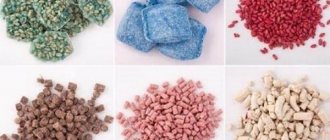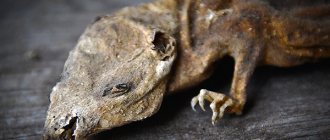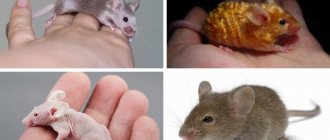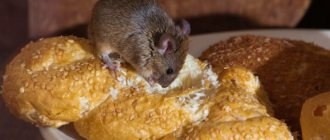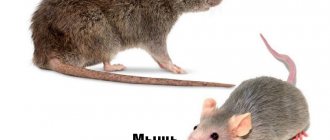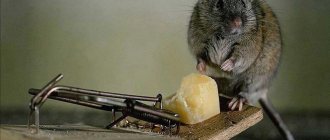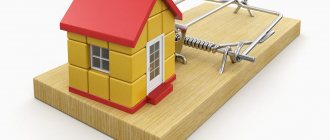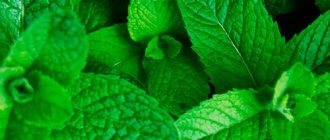What do house mice eat?
When living with a person as a pet, mice should receive a varied and balanced diet (including occasional treats in the form of fresh vegetables and fruits, seeds, cereals, herbs, nuts, bread, etc.). But on an ongoing basis, it is preferable to feed mice with ready-made food mixtures (with sufficient protein and fiber content) purchased at a pet store. At the same time, you should completely abandon some products.
What can you feed a mouse and what should you not feed it?
The simplest and easiest way to feed pet mice is industrially produced food. When choosing ready-made food, you should pay attention to the manufacturer (it is best if the food is foreign-made) and the composition of the product.
Thus, it is not recommended to purchase mixtures with a high content of oats, peanuts, sunflower seeds and grass granules. It is also worth giving up universal feeds (including those containing dyes). In terms of specific foods, mice can be given the following:
- Cereals (grains of oats, wheat, barley, rye, millet).
- Protein products. Sometimes it is useful to give the little ones a small piece of boiled quail egg, boiled chicken without salt, peeled boiled shrimp (without adding spices, and no more than once a week) and gammarus (dried freshwater crustaceans, which can be found in a pet store).
Feed sunflower seeds with caution. Due to their high fat content, they can be given no more than 3-4 pieces per day (otherwise the mouse will risk obesity).
- Nuts (peanuts, hazelnuts, walnuts). The recommended amount is no more than 1 nut per day.
- Fresh or dried fruits (apples, pears, peaches, apricots, bananas, grapes, kiwi, mango, etc.). They can be given as a treat 2-3 times a week.
- Berries (strawberries, currants, wild strawberries). The recommended norm is a few berries 1-2 times a week.
- Vegetables (cucumbers, bell peppers, cauliflower, pumpkin, broccoli, Brussels sprouts, but most of all mice love fresh carrots). They can be given every other day.
Sometimes you can give Bread (preferably black). It is recommended to give it in small pieces and very rarely - to diversify the diet.
- Greens (lettuce, parsley, cilantro). You can give in small quantities 2-3 times a week.
- Canned food crickets (should account for about 3% of the diet, as they contain a lot of protein, calcium and amino acids).
- Water (at least 25 grams per day). Mice should always have access to clean, fresh water.
- Twigs of apple, rowan and coniferous trees (good for teeth).
Note! Mice love cheese very much, but it is harmful to them because it negatively affects the liver and causes obesity. Therefore, you can give cheese occasionally in small quantities (as a tasty treat).
At the same time, the following foods must be completely excluded from the diet of mice:
- Any fried, salted and smoked dishes (including salted fish, smoked sausage, lard, chips, crackers, fried potatoes, etc.).
- Various sweets (sweets, ice cream, cakes, etc.).
- Food for other animals (dogs, cats, etc.).
- White cabbage.
- Potatoes in any form.
- Tomatoes.
- Citrus and various exotic fruits.
- Beetroot.
- Milk (because it provokes diarrhea, and many pets have intolerance to the product).
- Potent medicinal herbs with a bitter taste (in particular, wormwood, celandine, gentian, etc.).
- Onions (onions and greens).
- Rhubarb.
If, after eating a product, the mouse feels worse and has indigestion (even though the food is healthy), the diet must be urgently adjusted and the product replaced with a safer one.
How can overeating and obesity be dangerous?
Improper or unbalanced nutrition often leads to overeating and subsequent obesity of a small pet. They, in turn, are dangerous because:
- Lead to metabolic disorders.
- Negatively affect liver function.
- Increases the load on the heart.
Which ultimately makes the pet lethargic, sleepy, inactive, causes shortness of breath and alopecia areata (baldness), vascular diseases, gastrointestinal disorders, etc.
What can be given with caution?
Not all products are strictly contraindicated for house mice . Some of them can be given occasionally and in limited quantities (with caution, avoiding overeating), for example:
- Cookies and chocolate (you can give a small piece of a sweet treat, no more than once a week).
- Nuts and seeds (frequent consumption leads to obesity).
- Porridge (mice can be given porridge cooked in water and without adding salt/sugar - instead, it is recommended to add fruits or berries to the finished product).
- Salads (allowed without salt, spices and mayonnaise).
- Meat (you can only give boiled poultry or fish).
- Cheese (very rare and in limited quantities).
Important! The diet of a domestic mouse must be formulated in such a way that the animal receives a balanced diet, but at the same time does not overeat beyond the norm.
Are you trying to diversify your pet's menu?
Plant-based treats
It is known that mice like plant foods, since in nature the animals’ diet consists of grains, tree bark, seeds, fruits, and berries (they can snack on all the strawberries in the garden beds). Snacks of animal origin (snail or slug) are consumed much less frequently by rodents in natural environments.
Therefore, if the goal is to catch a mouse, then they lure the animal with fruits and grains:
- a piece of apple, plum, as well as apricot, peach, pear;
- fresh crust or crust of bread (it is better to moisten the bread with vegetable oil);
- spoon of porridge.
Mice leave their shelters to look for food up to 30 times during the night. So there are plenty of chances to catch them.
By the way! How do you make sure that the target object is a mouse and not a rat? And why is it important to know who is being hunted?
Bread
Mice love fresh bread soaked in vegetable oil (it’s better to take unrefined bread: it smells stronger). Pests may like sunflower oil, but they really love sesame oil: when they smell it, the animals lose all caution.
In addition to black bread, baked goods, sunflower seeds and other grains .
Important! If you don’t mind putting a bun or other baked goods in a mousetrap, then it should be fresh and fragrant. These animals will not take risks to eat a stale bun.
Muffins or bread have a dense consistency - this is an excellent bait for mice in a mousetrap: it is convenient to place on the trigger. The baked goods emit a strong odor, enough to make the rodent forget about caution.
Corn
Roasted seeds or rice, wheat, barley, any cereal, oatmeal cookie crumbs poured into a trap act like a magnet on pests. However, such products cannot be caught on a trigger - they are simply placed in a trap or poison is prepared from them by mixing in toxic substances.
Interesting! Traps that work without a hook are divided into three types: live traps (then you need to go farther from the house to release the animal), traps with poison, glue traps, and those that kill with an electric discharge. From a humane point of view, live traps are the most preferable: it is simply an enclosure in which mice remain completely unharmed and can also satiate their appetite. It is with such live traps that the most humane citizens begin their fight against rodents. But having received a couple of mouse surprises in the form of spoiled food or a burned-out system unit due to chewed wires, they say goodbye to illusions and move on to killing traps.
Fact! When dealing with mice, the first thing you need to do is make sure that you are dealing with them. Mouse gnawing marks and feces are similar to those left by young rats. These pests have different tastes, powers of smell, intelligence, and therefore their favorite treats. It is advisable to quickly catch at least one animal in order to recognize the enemy by sight.
Peanut butter
Make small balls from it or spread oil directly onto the working surface of the trap. Catching rodents using this product will be effective.
Interesting! Cheese is not a priority for mice. They do not secrete this product and rarely go into traps for it. After all, in nature, rodents have nowhere to get lactic acid food. Although some believe that pests are still susceptible to particularly odorous varieties of cheese.
What do mice eat in the wild?
The diet of mice in the wild is somewhat different from the domestic species. In particular, wild animals feed on agricultural crops (wheat, oats, rye, corn, millet), mushrooms, berries, nuts, small insects, vegetables, seeds of deciduous trees, plant roots, etc.
What do different types of mice eat, depending on the time of year?
Depending on their species, mice can eat differently (their diet is not very different from each other, but still).
Shrew or shrew mouse
The shrew mouse has a long nose, curved at the end, and is small in size (6-10 cm). Such a mouse is in search of food almost around the clock, because in order to maintain the necessary energy supply, they are forced to consume huge amounts of food . In the warm season, the shrew's diet consists of insects (worms, mole crickets, woodlice, caterpillars, etc.), but in winter mice have to be content with plant seeds.
Japanese mouse
The Japanese mouse has large round ears and a long nose, and prefers to live in mixed forests and on mountainous hills. In spring and summer, the animal eats everything it can find (fruits, berries, grains, vegetables, insects, herbs, etc.). In winter and autumn, mice have a hard time, and since there is not much to choose from, they consume dried insects (if they find them), dry roots and seeds of various plants, etc.
Wood mouse
A distinctive feature of the wood mouse is a round yellow spot on its chest. Animals live in abandoned burrows, in voids under stones, etc. In the warm season, they feed on cereals, nuts, insects, etc. In autumn and winter, the basis of the diet is dried herbs, roots and plant seeds.
Attention! Due to a poor diet during the cold season, most mice do not survive until summer.
Little mouse
The maximum body length of the animal is 7 cm, not counting the tail. The baby mouse prefers to live in grain fields, as well as in the steppe and forest-steppe. The animal is unpretentious in food and eats everything it can (grass, insects, berries, vegetables, etc.). In the cold season, the basis of the diet is seeds and roots of plants.
Harvest mouse
A distinctive feature of the animal is the presence of a clear, contrasting stripe on the skin, running along the entire spine. In the warm season, the field mouse feeds on invertebrate insects, fruits, berries, roots, flowers, plant stems and cereals. In winter, mice are content with tree bark, dried grass and roots. In spring, the basis of the diet is tree buds.
What do wild rodents like?
In nature, wild mice live where there is food that they can eat. They set up their home and replenish their food supplies throughout the fall. In search of food, mice usually leave their homes at night. Rodents prefer to eat plant foods. Animals living in the forest eat grass seeds, tree fruits, plant tops, nuts, acorns and mushrooms. They can also eat insects: various beetles, grasshoppers, spiders, caterpillars, crickets and even worms.
During the cold season, these mammals do not hibernate; they continue to lead an active lifestyle and, in case of hunger, begin to panic in search of food for themselves. In winter, animals cannot always be seen, as they try to move under the snow.
Meadow, steppe and field mice eat grain (millet, buckwheat, barley, wheat and oats), clover and fruits. The vole can also feed on cereal stems and seeds, and loves seedlings and flowers. The green part of plants, various buds, roots, leaves and shoots are what mice that live in swamps and along river banks feed on.
Often mice settle in beehives, where they begin to feed not only on dead, but also on living bees. In addition, they eat honey and bee bread, which is necessary for bees in early spring.
There are also mice in the house. They settle there when their supplies run out, causing damage to the structure and the harvest.
conclusions
The diet of mice in domestic and wild conditions is somewhat different, since the decorative species is fed for the most part with special food mixtures and various treats from the table, which the owners carefully treat the pet with.
Mice living in nature have to make do with what is around them. But both of them have extremely short life expectancies . Therefore, when keeping a pet mouse, it is necessary to adhere to a balanced diet, avoiding obesity and the resulting health problems.
Baits are attractive not only to mice
...but sometimes also for puppies, kittens and children . It is necessary to avoid situations where mouse treats flavored with poison may be within the reach of “non-target” objects.
To avoid such incidents, baits should be accessible exclusively to rodents. Traps should be placed in narrow spaces (under the refrigerator, in a kitchen cabinet, on pantry shelves). A cat, a dog, especially a child, will not get in there.
It is even safer to use bait stations. Essentially, these are boxes with several entrances only for pests; inside there is poisonous food that is completely inaccessible to other animals and children.
If we talk about baiting rodents at enterprises, then poisoned baits are sold immediately complete with such a station.
